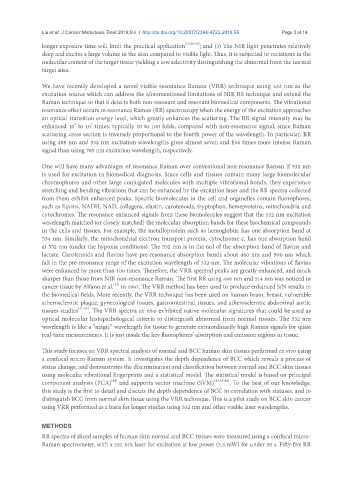Page 56 - Read Online
P. 56
Liu et al. J Cancer Metastasis Treat 2019;5:4 I http://dx.doi.org/10.20517/2394-4722.2018.55 Page 3 of 14
longer exposure time will limit the practical application [24,26,30] ; and (3) The NIR light penetrates relatively
deep and excites a large volume in the skin compared to visible light. Thus, it is subjected to variations in the
molecular content of the target tissue yielding a low selectivity distinguishing the abnormal from the normal
target sites.
We have recently developed a novel visible resonance Raman (VRR) technique using 532 nm as the
excitation source which can address the aforementioned limitations of NIR RS technique and extend the
Raman technique so that it detects both non-resonant and resonant biomedical components. The vibrational
resonance effect occurs in resonance Raman (RR) spectroscopy when the energy of the excitation approaches
an optical transition energy level, which greatly enhances the scattering. The RR signal intensity may be
3
2
enhanced 10 to 10 times, typically 10 to 100 folds, compared with non-resonance signal, since Raman
scattering cross section is inversely proportional to the fourth power of the wavelength. In particular, RR
using 488 nm and 532 nm excitation wavelengths gives almost seven and five times more intense Raman
signal than using 785 nm excitation wavelength, respectively.
One will have many advantages of resonance Raman over conventional non-resonance Raman if 532 nm
is used for excitation in biomedical diagnosis. Since cells and tissues contain many large biomolecular
chromophores and other large conjugated molecules with multiple vibrational bonds, they experience
stretching and bending vibrations that can be enhanced by the excitation laser and the RR spectra collected
from them exhibit enhanced peaks. Specific biomolecules in the cell and organelles contain fluorophores,
such as flavins, NADH, NAD, collagens, elastin, carotenoids, tryptophan, hemeproteins, mitochondria and
cytochromes. The resonance enhanced signals from these biomolecules suggest that the 532 nm excitation
wavelength matched (or closely matched) the molecular absorption bands for these biochemical compounds
in the cells and tissues. For example, the metalloprotein such as hemoglobin, has one absorption band at
534 nm. Similarly, the mitochondrial electron transport protein, cytochrome c, has one absorption band
at 552 nm (under the hypoxia conditions). The 532 nm is in the tail of the absorption band of flavins and
lactate. Carotenoids and flavins have pre-resonance absorption bands about 480 nm and 500 nm which
fall in the pre-resonance range of the excitation wavelength of 532 nm. The molecular vibrations of flavins
were enhanced by more than 100 times. Therefore, the VRR spectral peaks are greatly enhanced, and much
sharper than those from NIR non-resonance Raman. The first RR using 488 nm and 514 nm was noticed in
[11]
cancer tissue by Alfano et al. in 1987. The VRR method has been used to produce enhanced S/N results in
the biomedical fields. More recently, the VRR technique has been used on human brain, breast, vulnerable
atherosclerotic plaque, gynecological tissues, gastrointestinal tissues, and atherosclerotic abdominal aortic
tissues studies [37-43] . The VRR spectra ex vivo exhibited native molecular signatures that could be used as
optical molecular histopathological criteria to distinguish abnormal from normal tissues. The 532 nm
wavelength is like a “magic” wavelength for tissue to generate extraordinarily high Raman signals for quasi
real-time measurements. It is just inside the key fluorophores’ absorption and emission regions in tissue.
This study focuses on VRR spectral analysis of normal and BCC human skin tissues performed ex vivo using
a confocal micro-Raman system. It investigates the depth dependence of BCC which reveals a process of
status change, and demonstrates the discrimination and classification between normal and BCC skin tissues
using molecular vibrational fingerprints and a statistical model. The statistical model is based on principal
[44]
component analysis (PCA) and supports vector machine (SVM) [43,45-48] . To the best of our knowledge,
this study is the first to detail and discuss the depth dependence of BCC in correlation with statuses, and to
distinguish BCC from normal skin tissue using the VRR technique. This is a pilot study on BCC skin cancer
using VRR performed as a basis for longer studies using 532 nm and other visible laser wavelengths.
METHODS
RR spectra of sliced samples of human skin normal and BCC tissues were measured using a confocal micro-
Raman spectrometer, with a 532 nm laser for excitation at low power (3.5 mW) for under 30 s. Fifty-five RR

